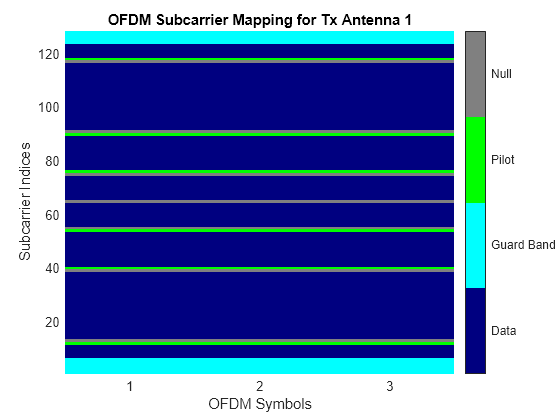MIMO シミュレーションでの OFDM の適用
単純な 2×2 シングルユーザー MIMO のエラー レート シミュレーションで OFDM 変調器と復調器を使用します。OFDM パラメーターは 802.11n 標準に基づいています。
ユーザー指定のパイロット インデックス、挿入された DC null、2 つの送信アンテナおよび 2 つの受信アンテナを使用する OFDM 変調器と復調器のペアを作成します。アンテナによって異なるパイロット インデックスを指定します。
ofdmMod = comm.OFDMModulator(FFTLength=128, ... PilotInputPort=true, ... NumSymbols=3, ... PilotCarrierIndices= ... cat(3,[12; 40; 54; 76; 90; 118],[13; 39; 55; 75; 91; 117]), ... InsertDCNull=true, ... NumTransmitAntennas=2); ofdmDemod = comm.OFDMDemodulator(ofdmMod); ofdmDemod.NumReceiveAntennas = 2;
各送信アンテナのパイロット サブキャリアのリソース マッピングを表示します。図のグレーの線は、パイロット信号の干渉を最小限にするための null サブキャリアの挿入を示しています。
showResourceMapping(ofdmMod)


info メソッドを使用して、OFDM 変調器の次元を決定します。
ofdmModDim = info(ofdmMod); numDataSc = ofdmModDim.DataInputSize(1); % Number of data subcarriers numSym = ofdmModDim.DataInputSize(2); % Number of OFDM symbols numTxAnt = ofdmModDim.DataInputSize(3); % Number of transmit antennas
QPSK 変調を使用して 100 個の OFDM フレームが生成されるようにパラメーターを設定します。
nframes = 100;
M = 4; % Modulation order to QPSKエラー レート カウンターを作成します。
errorRate = comm.ErrorRate;
2×2 のフラット レイリー フェージング チャネルを想定して、100 フレームにわたって OFDM システムのシミュレーションを実行します。単純な最小二乗解を使用してマルチパス フェージングの影響を取り除き、OFDM 波形と QPSK データを復調します。元のデータを復調されたデータと比較して、誤り統計を生成します。
for k = 1:nframes % Generate a frame of user data dataIn = randi([0 M-1],numDataSc*numSym*numTxAnt,1); % Split the user data into two different streams and map to QPSK % symbols streamDataOut = reshape(dataIn,numTxAnt,[]).'; mapperOut = pskmod(streamDataOut,M,pi/4); % Generate random OFDM pilot symbols pilotData = complex(rand(ofdmModDim.PilotInputSize), ... rand(ofdmModDim.PilotInputSize)); % Reshape the modulated data streams to match the OFDM modulator % requirements and modulate the symbols using OFDM ofdmModData = reshape(mapperOut,numDataSc,numSym,numTxAnt); dataOFDM = ofdmMod(ofdmModData,pilotData); % Create flat, i.i.d., Rayleigh fading channel 2-by-2 channel chGain = complex(randn(2,2),randn(2,2))/sqrt(2); % Pass OFDM signal through Rayleigh and AWGN channels receivedSignal = awgn(dataOFDM*chGain,30); % Apply least squares solution to remove effects of fading channel rxSigMF = chGain.' \ receivedSignal.'; % Demodulate OFDM data receivedOFDMData = ofdmDemod(rxSigMF.'); % Form the received streams receivedOFDMStreams = reshape(receivedOFDMData,[],numTxAnt); % Demodulate QPSK data receivedStreams = pskdemod(receivedOFDMStreams,M,pi/4); % Demap the data from each rx stream back to the user data receivedData = reshape(receivedStreams.',[],1); % Compute error statistics errors = errorRate(dataIn,receivedData); end
誤りの統計を表示します。
fprintf('\nSymbol error rate = %d from %d errors in %d symbols\n',errors)Symbol error rate = 8.996795e-02 from 5614 errors in 62400 symbols